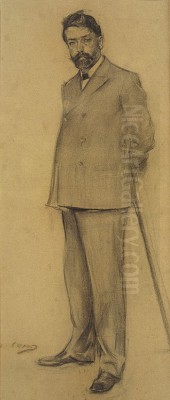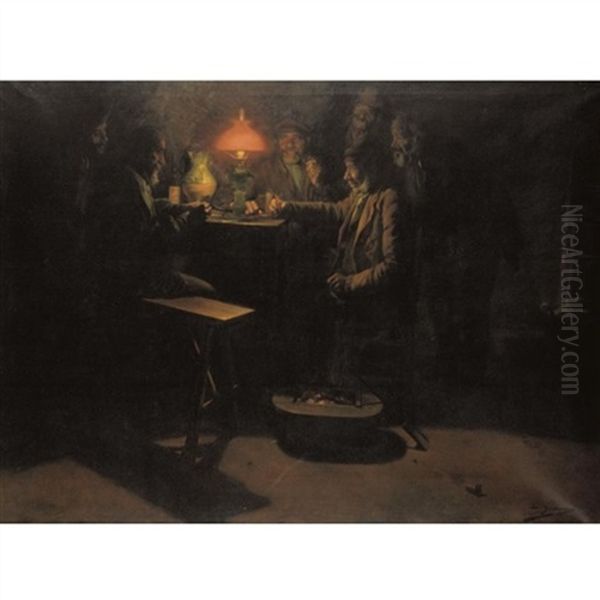
Lluís Graner i Arrufí stands as a significant, albeit sometimes overlooked, figure in the vibrant tapestry of Catalan art at the turn of the 20th century. Born in Barcelona in 1863 and passing away in the same city in 1929, Graner carved a unique path for himself. He was primarily known as a painter deeply rooted in the Realist tradition, yet he possessed an innovative spirit that led him to explore the fusion of different art forms, inspired by grand concepts like Richard Wagner's Gesamtkunstwerk (Total Work of Art). His career reflects both a dedication to capturing the nuances of everyday life and a pioneering interest in multimedia spectacles, making him a fascinating bridge between academic painting and modern artistic experimentation.
Early Training and Foundations in Realism
Graner's artistic journey began formally at the prestigious Llotja School of Fine Arts in Barcelona (Escola de la Llotja). This institution was a cornerstone of artistic education in Catalonia, nurturing generations of painters and sculptors. During his time there, Graner studied under notable figures, including Antoni Caba i Casamitjana (1838-1907). Caba was a respected portraitist and history painter, himself trained in the academic traditions of Madrid and Paris, and a key proponent of Realism within the Catalan context. Under Caba's tutelage, Graner honed his skills in draughtsmanship and developed the meticulous observational approach that would characterize much of his oeuvre.
The Llotja at this time was a crucible of talent. While Graner absorbed the lessons of Realism, the school also saw students and teachers who would contribute to the burgeoning movement of Modernisme (Catalan Modernism). Figures like Modest Urgell i Inglada, known for his evocative, often melancholic landscapes, also taught at the Llotja. Graner's contemporaries, or near-contemporaries, who passed through the Llotja included artists who would become central to Modernisme, such as Santiago Rusiñol and Ramon Casas, although their artistic paths would diverge significantly from Graner's more consistent Realism.

Graner's commitment to Realism manifested in his choice of subject matter. He often turned his attention to the lives of ordinary people, sometimes focusing on marginalized figures or scenes of daily labor and existence. This aligns with the broader European Realist movement, exemplified by artists like Gustave Courbet and Jean-François Millet in France, who sought to depict the unvarnished truth of contemporary life, moving away from idealized historical or mythological subjects. Graner’s work, therefore, participated in this wider artistic current, bringing a focus on social observation to the Catalan scene.
The Influence of Wagner and the Pursuit of the Total Artwork
A defining aspect of Graner's artistic vision was his profound admiration for the German composer Richard Wagner (1813-1883) and his concept of the Gesamtkunstwerk. Wagner believed that the highest form of art could only be achieved through the synthesis of multiple disciplines – music, drama, poetry, and the visual arts – working in concert to create a unified, immersive experience. This idea resonated deeply with Graner and spurred him to move beyond the confines of the painted canvas.
This Wagnerian influence found its most ambitious expression in Graner's creation of the Sala Mercè in Barcelona. Opened in 1904, this venue was conceived as a space dedicated to "visual auditions" and multimedia spectacles. Significantly, Graner collaborated with the legendary Catalan architect Antoni Gaudí (1852-1926) on the design and renovation of the hall, located in the basement of the Teatro Principal on La Rambla. Gaudí, already famous for his unique architectural language, brought his distinctive organic forms and structural ingenuity to the project, creating a suitably atmospheric setting for Graner's artistic experiments.
The Sala Mercè was groundbreaking for its time. It aimed to integrate painting, music, poetry, theatre, and even early cinematography. Graner organized elaborate shows that combined projected images (including his own paintings transformed into lantern slides), live music, dramatic recitations, and sophisticated lighting effects. These events sought to create the kind of immersive, multi-sensory experience envisioned by Wagner. The Sala Mercè quickly became a hub for Barcelona's cultural elite, attracting artists, writers, musicians, and prominent figures from the entertainment world. It stands as an early and important example of multimedia performance space in Spain, predating similar experiments by later avant-garde artists like Salvador Dalí.
Artistic Style: Realism, Light, and Venetian Echoes
While Graner experimented with multimedia, his primary identity remained that of a painter. His style was predominantly Realistic, characterized by careful attention to detail, solid composition, and a truthful representation of his subjects. He was particularly adept at capturing the effects of light, especially artificial light sources like gas lamps or candlelight, which often feature in his interior scenes and nocturnal landscapes. This interest in light effects connects him to a lineage of painters stretching back to the Baroque, such as Georges de La Tour, but applied to contemporary settings.
His subject matter ranged from intimate genre scenes and portraits to landscapes and cityscapes. The focus on marginalized figures, mentioned earlier, adds a layer of social commentary to his work, aligning him with artists like Isidre Nonell, another Catalan contemporary known for his poignant depictions of the poor and outcast, though Nonell's style was more expressive and less strictly Realistic.
One of Graner's notable works, Piazzetta, showcases a different facet of his influences. This painting depicts a view of the Piazzetta di San Marco in Venice, looking south. The style employed in this work is explicitly linked to that of Giovanni Antonio Canal, better known as Canaletto (1697-1768). Canaletto was the preeminent Venetian veduta (view) painter of the 18th century, celebrated for his detailed, luminous, and topographically accurate cityscapes of Venice. By adopting a Canaletto-like style, Graner demonstrated his technical versatility and his engagement with art history, paying homage to a master known for precision and atmospheric clarity. While the provided text also mentions Canaletto as a printmaker, his fame rests overwhelmingly on his paintings. Graner's Piazzetta reflects this painterly tradition of detailed urban views.
Exhibitions, Recognition, and International Presence
Lluís Graner was an active participant in the art world, exhibiting his work regularly both in Spain and abroad. His consistent presence is evidenced by records of solo exhibitions held in Barcelona in multiple years, including 1912, 1913, 1920, 1926, and notably, the year of his death, 1929. This indicates a sustained period of artistic production and public engagement throughout his later career.
His reputation extended beyond Catalonia. He showcased his works in various European cities, contributing to the international visibility of Spanish art during this period. A specific instance of his international activity was an exhibition held in 1910 at the Edward Brandus Art Galleries in New York City, demonstrating an effort to reach audiences across the Atlantic.
Furthermore, Graner participated in significant group exhibitions. In 1920, he took part in a collective show in São Paulo, Brazil, alongside artists such as Almeida Brito. This suggests connections with the art scenes in the Portuguese-speaking world. The same year, he was involved in exhibitions organized by the Italian Artists Association, highlighting his engagement with broader European artistic networks.
The quality and importance of Graner's work were recognized through acquisitions by major Spanish museums. His paintings entered the collections of the Museo Nacional del Prado in Madrid (formerly listed sometimes under its older name, Museo Nacional de Bellas Artes) and the Museo de Bellas Artes de Sevilla. The presence of his work in these national institutions underscores his standing within the canon of Spanish art history.
Contextualizing Graner: Modernisme and Political Undertones
Graner operated during the height of Catalan Modernisme, a cultural and artistic movement roughly analogous to Art Nouveau and Jugendstil elsewhere in Europe. While his style remained largely Realistic, he was undeniably part of the vibrant cultural milieu of Barcelona that included Modernista giants like Gaudí, Rusiñol, Casas, and the architect Lluís Domènech i Montaner. His collaboration with Gaudí on the Sala Mercè places him directly within this innovative context, even if his painting style differed from the decorative, symbolist, or expressive tendencies often associated with Modernisme.
There are also indications of Graner's engagement with the political currents of his time. One of his known works is titled El comité rojo (The Red Committee), which is housed in the Museo de Bellas Artes de Sevilla. The title suggests a depiction of a political meeting, possibly related to republican or leftist movements. The provided text mentions an association with Republicanism and "El Comité Rojo" during the Spanish Republic. However, caution is needed here: Graner died in 1929, two years before the establishment of the Second Spanish Republic (1931-1939). It's possible the painting depicts an earlier republican committee or group, or perhaps reflects the general political ferment of the era. Without viewing the painting or having more specific historical context, its exact meaning remains somewhat speculative, but it points towards an artist attuned to the social and political landscape. His engagement with realism often inherently involved depicting social realities, which could carry political undertones.
Compared to contemporaries like Joaquín Sorolla, whose luminous paintings captured the Spanish sun and beach life with an Impressionist-influenced technique, Graner's work often delved into more somber or socially observant themes, rendered with a more traditional Realist technique, albeit one highly skilled in capturing light and atmosphere. He shared with Spanish Realist predecessors like Mariano Fortuny a dedication to technical skill, though Fortuny's work often had a more historical or Orientalist flavour.
Later Years and Legacy
Lluís Graner continued to paint and exhibit actively until the end of his life in 1929. His career spanned a period of significant artistic change, from the dominance of academic Realism to the rise of Modernisme and the beginnings of the avant-garde movements that would define the 20th century. While he remained largely faithful to Realism in his painting, his foray into multimedia spectacles with the Sala Mercè demonstrated a forward-looking sensibility.
His legacy is twofold. On one hand, he was a highly accomplished Realist painter, skilled in capturing the nuances of light, atmosphere, and human character. His works provide valuable depictions of Catalan life and landscapes from his era. On the other hand, his collaboration with Gaudí and his pioneering experiments at the Sala Mercè mark him as an innovator who embraced the Wagnerian ideal of the total artwork and anticipated later developments in performance art and immersive media. He stands as a testament to the rich diversity of artistic practice within the Catalan art scene, a figure who mastered traditional forms while boldly exploring new possibilities for artistic expression. His work continues to be appreciated for its technical mastery and its unique blend of observation and spectacle.
Conclusion: A Painter of Reality and Vision
Lluís Graner i Arrufí occupies a unique position in Spanish art history. As a painter, he was a master of Realism, following in the footsteps of his teacher Antoni Caba and contributing significantly to the depiction of Catalan society and environments with sensitivity and skill. His works, found in major Spanish museums, attest to his technical prowess and his keen eye for detail and light.
Simultaneously, Graner was a visionary inspired by Richard Wagner's ideas. His creation of the Sala Mercè, in collaboration with Antoni Gaudí, was a pioneering venture into multimedia performance, integrating painting, music, theatre, and early film in ways that were ahead of their time. This innovative spirit, combined with his solid foundation in Realist painting, makes Graner a complex and compelling figure. He navigated the transition from the 19th to the 20th century not just by adhering to established traditions, but by actively seeking new ways to synthesize art forms and create powerful, immersive experiences, leaving behind a legacy that encompasses both the canvas and the stage.